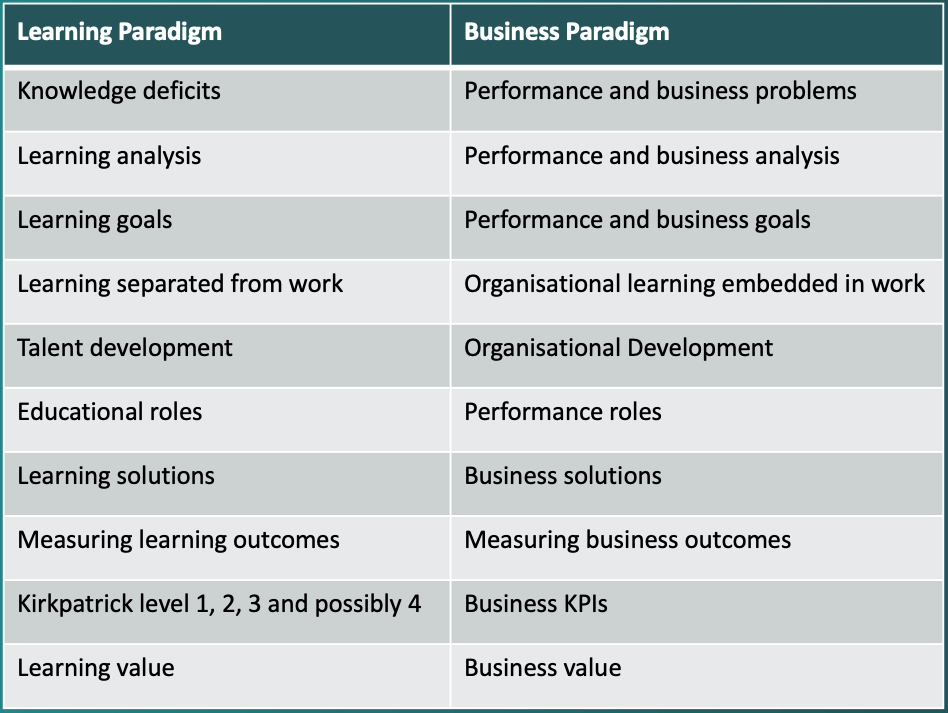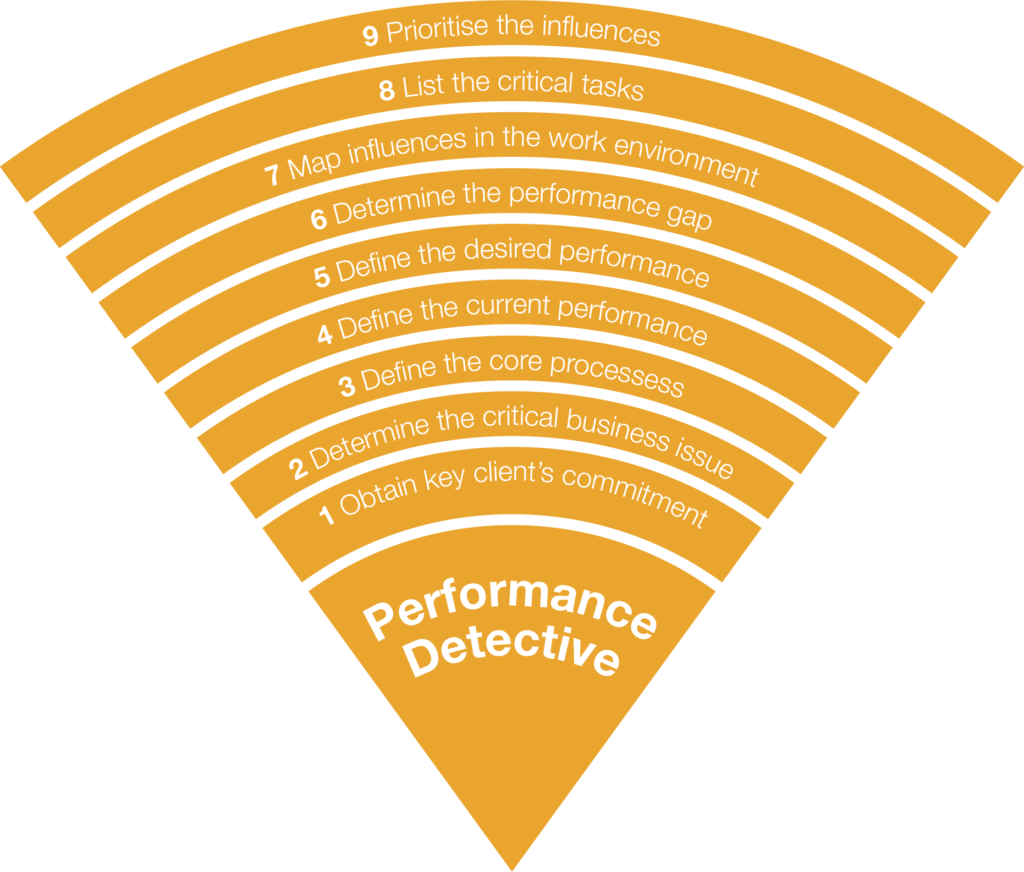Author: Charles Jennings
SUMMARY
Two critical factors inhibiting L&D from delivering real value are the lack of effective performance analysis and the lack of comprehensive solutions aimed at solving organisational and business problems. Our obsession with skills training and development is also part of the problem. All of these are linked.
Whenever L&D is presented with a business problem, it makes good business sense to first focus on identifying the root causes of gaps between current and desired performance in the workplace and fix them rather than hoping one-off skills training will ‘fix’ individuals and solve the issue.
The skills business
Skills training is big business.
The 2019 Global Corporate Training Market was valued at USD 370.3 billion.[1] A large proportion of this training spend is dedicated to skills development.
In 2019 USA total training expenditures, including all training-related costs (training budgets, technology spend, and training staff salaries) were calculated at USD83 billion.[2]
In England (not the UK) total investment in adult skills is estimated at GBP18 billion for on-the-job training plus another GBP18bn for off-the-job training.[3] Again, this may appear an extremely large commitment for a nation, but the UK only ranks 22nd in Europe for training and skills spend. The three European countries that invest most in corporate learning are Belgium, France, and the Netherlands.
Whichever way all these figures are examined, they represent an extremely large investment in formal training and skills development.
Poor performance is due to more than lack of skills
It is important to ask whether all this effort and is money being well spent.
What processes do governments and organisations employ to ensure that their training and skills development services are effective and help solve structural and business problems? How much of the training is transferred into practical use for current and future needs to drive national and organisational success? Is the training directed to real and verified needs?
Is our focus on skills and competencies (the of aggregation knowledge, skills, and attitudes).[4] the best way to address national and organisational performance problems? Will it deliver real value, or are there better ways?
One thing we do know is that a lack of skills is only a minor contributor to most organisational performance problems. People don’t exist in a performance vacuum.[5]
Systems, processes, and performers
The root cause of underperformance is more likely to lie not in the performer but in poor systems and processes. Task interference is a well-described factor that inhibits performance. The interference may come from lack of clarity about objectives, other tasks competing for time and attention, poor procedures and workflow design, inadequate resources, tools, time, staff, or information,[6] or other sources.
Deeming[7] found that up to 94% of the variations observed in worker performance have nothing to do with the worker. Instead, most of the performance variations are caused by the system in which people are working. Deming insisted that ‘people can’t perform better than the system allows’. Management has responsibility for the system.
An ounce (gram) of analysis is worth a pound (kilogram) of skills training
Evidence suggests focus on skills-building at the expense of carrying out a systemic analysis to determine the real underlying issues is not only wasting huge amounts of money, but also inhibiting our ability to develop high performing individuals, teams and organisations.
This leads to an important question for L&D leaders. How can we identify which elements of the organisational or business problem we’re seeking to solve is due to lack of skills, and which is due to poor systems, processes, and other factors?
Once we have answers to that question, we can direct our efforts to developing the right solutions to solve the right problems.
Problem analysis accepted as the first step in any process to improve systems, processes, procedures, designs, and people-centric performance.
When a technician addresses a technical problem, they will draw on their experience and on proven approaches to examine all the relevant factors and elements that helps them to uncover the core cause or causes. Once the underlying causes have been found, appropriate solutions can be developed. This problem analysis approach is so well proven that is it used in almost every walk of life.
Problem analysis starts with identifying current performance and comparing it to desired performance. Only once the performance gap has been quantified, and the core causes of that gap identified, can a solution be built.
This lack of performance analysis is endemic in Learning and Development.
Performance consulting or learning consulting?
An increasing number of L&D departments claim to use performance analysis and performance consulting to identify needs and design solutions to solve their organisations’ problems and build their organisations’ workforce capabilities. Unfortunately, many are mistaken.
The problem often lies in the fact that many L&D professionals believe they are using performance consulting techniques when, in fact, they are using learning consulting techniques.
A good question to test this is to ask whether the solutions developed are primarily learning solutions.
Performance consulting is a practice that has evolved from the work of Thomas Gilbert, Geary Rummler, and others who developed the structured practice of Human Performance Improvement (HPI or HPT). There’s no doubt that effective performance consulting helps L&D professionals focus on the underlying performance problems. But this is extremely different from seeing performance improvement through a skills monocle.
Performance consulting is not a tool simply to analyse individual knowledge deficits. It is not a tool to analyse individual skills deficits either. It is certainly not a tool whose output is likely to be training alone. In practice, the output of proper performance consulting can often include no training or individual development at all.
If L&D is to address the over-reliance on skills training and individual development as a solution for performance issues, we need to think and act differently. We need to adopt systemic approaches more akin to Six Sigma, Lean, and Agile methodologies than to instructional design. We need to focus on helping our organisations create cultures of continuous improvement rather than ones of ‘continuous learning’. The latter is often interpreted by L&D professionals as providing more formal learning solutions in the workplace rather than solutions directly targeted at improving the outputs of work.
The methodologies needed are in the performance paradigm.
Moving from the learning paradigm to the performance paradigm
The focus on skills and competencies ties L&D to learning solutions rather than performance solutions. It holds L&D in the learning paradigm.
If L&D is to demonstrate real value and organisational performance improvement, it is vital we move beyond individual development and beyond the learning paradigm. This is not to say that individual development is not important. Of course, it is. Especially in terms of helping advance individual careers and as a contributing factor to overall performance. It is just not as important was we have been led to believe and doesn’t deserve L&D’s sole, or even major, attention.
If L&D departments are to escape the skills vortex and deliver real value, it is essential they move mindsets from the learning paradigm to the performance paradigm, and practices from learning analysis to performance analysis and learning solutions to performance and business solutions.
The scale of this move should not be underestimated. It involves L&D addressing challenges in different ways, in working with stakeholders in new ways, in formulating solutions in different ways, and in measuring the impact of solutions in new ways.
The fundamental differences between the learning paradigm and performance paradigm are shown in Fig.1[8]

This move provides significant opportunities for L&D to change, remain relevant and add value. However, the move involves more than mindset and paradigm change. It involves process changes as well.
PERFORMANCE-BASED LEARNING IN ACTION – CASE
At Tulser we work with clients to help their L&D departments work and achieve results in the performance paradigm. This involves solving business problems in new and innovative ways based on our Performance-Based Learning Methodology™.
CASE STUDY: HILTI
THE CHALLENGE
The Global Project and Development Manager at Hilti contacted us and asked to help improve Hilti’s ability to onboard new front-line leaders and their team members and get them productive and adding value for the company as quickly as possible.
The challenge involved developing L&D capability. We were asked:
Would it be possible to organize a programme to build our L&D capability?
The business problem Hilti needed to solve was:
- Onboarding and retention issues. 33% turnover through promotions and departures.
- New salespeople were taking too long to reach productivity.
- Average time-to-productivity and payback for more than 50% of sales was greater than 1 year and often almost 2 years.
- Existing training programs were taking too long and didn’t include critical tasks needed to deliver value.
THE SOLUTION
Together with the Hilti global team, Tulser created a 70:20:20 /performance-based learning journey for Hilti.
A project team of 15 people, plus a stakeholder group of six including one executive board member, the CEO and four region heads, started to work on the overall project to improve onboarding as part of the program. This work continued after the program was completed.
We supported the Hilti team to use our methodology for developing solutions. This starts with agreeing organisational results, identifying key processes, environmental influences, and critical tasks. We then used the principle of ‘design for the 100. Start with the 70’.
THE RESULT
Not only was the solution design received ‘amazingly well’ by stakeholders and L&D heads, the measures of success – self-sufficiency within six months, locally-defined performance targets and team engagement, as well as other KPIs – were all significantly improved.
Tangible outputs from the engagement were projects that delivered new ways of building capability at speed and with faster results.
“The new approach has helped Hilti to improve its onboarding programmes and dramatically reduce the time-to-performance for employees. In some of its markets Hilti has seen this reduce from around 18 months to between 3 and 6 months.”
Rachel Hutchinson – Global Project and Development Manager
“It isn’t just time. We can see the difference in real business results. Comparing sales results from our South East Asia new hires in 2015/6, we see that then 58% took more than one year to pay for themselves. Another 15% took more than six months. Hilti was essentially losing money on 73% of the new hires for 6-24 months. Now 80% are reaching that point in less than three months, and another 5% in 4-6 months”
Terry Copley – Head of Learning Solutions and Experience
From Skills to Critical Tasks
The first change required is to replace competencies and skills as the molecules and atoms of performance and replace them with critical tasks.
Critical tasks are at the core of performance analysis in the Performance-Based Learning methodology.[9] Identifying and defining critical tasks is one of the fundamental activities of the Performance Detective role in the methodology. The Performance Master Builder takes these critical tasks and co-creates solutions.
The way the best performers execute critical tasks defines one of the main reasons they are the best performers. In order to complete critical tasks well they require more than individual capability (skill), but also an enabling environment and often the right guidance around the point of need.
Critical tasks are usually the basis of an organisation’s performance standards. When they’re not being performed, people notice.
They’re essential ingredients of the organisation’s professionalism.
They have an impact of on customers’ and employee’ perceptions of the organisation’s quality.
They are recognised by peers as critical to successfully completing outcomes. When completed in the right order and right time, they produce the desired outcomes.[10]
The Performance Detective: the first step in escaping the skills vortex
Correct use of performance consulting based around critical skills, when combined with effective holistic solution design, will help L&D escape from the skills vortex.
Effective performance consulting focuses on identifying all the issues that contribute to organisational problems not just skills problems.
Solutions built on effective performance consulting in turn build organisational capability, resilience, innovation, and agility rather than simply focusing on building individual skills, capability, resilience, and agility.
The critical tasks carried out by the Performance Detective role[11] are an important starting point for any performance analysis. However, they need to be followed by design that goes beyond learning solutions if L&D is to escape the skills vortex.

[1] Statista https://www.statista.com/statistics/738399/size-of-the-global-workplace-training-market/
accessed 1st October 2020 [2] 2019 Training Industry Report. https://trainingmag.com/sites/default/files/2019_industry_report.pdf [3] Social Mobility Commission. The adult skills gap: is falling investment in UK adults stalling social mobility? January 2019. https://assets.publishing.service.gov.uk/government/uploads/system/uploads/attachment_data/file/774085/Adult_skills_report_2019.pdf [4] International Labour Organisation (ILO) definition. Glossary of Key Terms on Learning and Training for Work. 2006. ISBN 9789290494331 [5] Rummler. G.A., and Brache.A.P. The Systems View of Human Performance. Training, v25 n9 p45-50,52-53 Sep 1988 [6] Rummler. G.A., and Brache.A.P. ibid. [7] Deming. W. Edwards., The System of Profound Knowledge (SoPK) [8] Arets. J. Value Creation with four business models for L&D. 2017. 70:20:10 Institute. https://tulser.com/wp-content/uploads/New-Value-Creation_with-four-Business-Models-for-LD.pdf [9] Arets.J., Jennings. C., Heijnen.V., 702010 Towards 100% Performance. 2015. Sutler Media. ISBN 978-9082397833 [10] Ibid. [11] Arets.J., Jennings. C., Heijnen.V., 702010 Towards 100% Performance. 2015. Sutler Media. ISBN 978-9082397833

